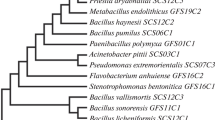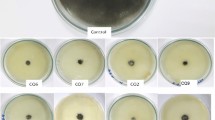Abstract
A total of 74 morphologically distinct bacterial colonies were selected during isolation of bacteria from different parts of tomato plant (rhizoplane, phylloplane and rhizosphere) as well as nearby bulk soil. The isolates were screened for plant growth promoting (PGP) traits such as production of indole acetic acid, siderophore, chitinase and hydrogen cyanide as well as phosphate solubilization. Seven isolates viz., NR4, NR6, RP3, PP1, RS4, RP6 and NR1 that exhibited multiple PGP traits were identified, based on morphological, biochemical and 16S rRNA gene sequence analysis, as species that belonged to four genera Aeromonas, Pseudomonas, Bacillus and Enterobacter. All the seven isolates were positive for 1-aminocyclopropane-1-carboxylate deaminase. Isolate NR6 was antagonistic to Fusarium solani and Fusarium moniliforme, and both PP1 and RP6 isolates were antagonistic to F. moniliforme. Except RP6, all isolates adhered significantly to glass surface suggestive of biofilm formation. Seed bacterization of tomato, groundnut, sorghum and chickpea with the seven bacterial isolates resulted in varied growth response in laboratory assay on half strength Murashige and Skoog medium. Most of the tomato isolates positively influenced tomato growth. The growth response was either neutral or negative with groundnut, sorghum and chickpea. Overall, the results suggested that bacteria with PGP traits do not positively influence the growth of all plants, and certain PGP bacteria may exhibit host-specificity. Among the isolates that positively influenced growth of tomato (NR1, RP3, PP1, RS4 and RP6) only RS4 was isolated from tomato rhizosphere. Therefore, the best PGP bacteria can also be isolated from zones other than rhizosphere or rhizoplane of a plant.



Similar content being viewed by others
References
Dutta S, Podile AR (2010) Plant growth promoting rhizobacteria (PGPR): the bugs to debug the root zone. Crit Rev Microbiol 36:232–244
Podile AR, Kishore GK (2006) Plant-associated bacteria. In: Gnanamanickam SS (ed) Plant growth promoting rhizobacteria. Springer, Amsterdam, pp 195–230
Sashidhar B, Podile AR (2010) Mineral phosphate solubilization by rhizosphere bacteria and scope for manipulation of the direct oxidation pathway involving glucose dehydrogenase. J Appl Microbiol 109:1–12
Manjula K, Podile AR (2001) Chitin-supplemented formulations improve biocontrol and plant growth promoting efficiency of Bacillus subtilis AF 1. Can J Microbiol 47:618–625
O’ Toole GA, Kolter R (1998) Initiation of biofilm formation in Pseudomonas fluorescens WCS365 proceeds via multiple, convergent signalling pathways: a genetic analysis. Mol Microbiol 28:449–461
Das SN, Dutta S, Anil K, Neeraja Ch, Sarma PVSRN, Srinivas V, Podile AR (2010) Plant growth promoting chitinolytic Paenibacillus elgii responds positively to tobacco root exudates. J Plant Growth Regul 29:409–418
Dutta S, Rani TS, Podile AR (2013) Root exudate-induced alterations in Bacillus cereus cell wall contribute to root colonization and plant growth promotion. PLoS One 8(10):e78369
Ahmad F, Ahmad I, Khan MS (2008) Screening of free living rhizospheric bacteria for their multiple plant growth promoting activities. Microbial Res 163:173–181
Li Z, Chang S, Lin L, Li Y, An Q (2011) A colorimetric assay of 1-aminocyclopropane-1-carboxylate (ACC) based on ninhydrin reaction for rapid screening of bacteria containing ACC deaminase. Lett Appl Microbiol 53:178–185
Yousef CF, Travieso ML, Espinosa UM (2008) Different, overlapping mechanisms for colonization of abiotic and plant surfaces by Pseudomonas putida. FEMS Microbiol Lett 288:118–124
Indira Devi S, Talukdar NC, Sharma NC, Jeyaram K, Rohinikumar M (2011) Screening of rhizobacteria for their plant growth promotion ability and antagonism against damping off and root rot diseases of broad bean (Vicia faba L.). Indian J Microbiol 51:14–21
Vyas P, Rahi P, Chadha BS, Gulati A (2014) Statistical optimization of medium components for mass production of plant growth-promoting microbial inoculant Pseudomonas trivialis BIHB 745 (MTCC5336). Indian J Microbiol 54(2):239–241
Sharma S, Kaur M (2010) Antimicrobial activities of rhizobacterial strains of Pseudomonas and Bacillus strains isolated from rhizosphere soil of carnation (Dianthus caryophyllus cv. Sunrise). Indian J Microbiol 50:229–232
Kaki AA, Chaouche NK, Dehimat L, Milet A, Youcef-Ali M, Ongena M, Thonart P (2013) Biocontrol and plant growth promotion characterization of Bacillus species isolated from Calendula officinalis rhizosphere. Indian J Microbiol 53:447–452
Mayak S, Tirosh T, Glick BR (2004) Plant growth-promoting bacteria that confer resistance to water stress in tomato and pepper. Plant Sci 166:525–530
Wahyudi AT, Astuti RP, Widyawati A, Meryandini A, Nawangsih AA (2011) Characterization of Bacillus sp. strains isolated from rhizosphere of soybean plants for their use as potential plant growth for promoting rhizobacteria. J Microbiol Antimicrobials 3:34–40
Joseph B, Patra RR, Lawrence R (2007) Characterization of plant growth promoting rhizobacteria associated with chickpea (Cicer arietinum L.). Int J Plant Prod 1:141–152
Bal HB, Nayak L, Das S, Adhya TK (2013) Isolation of ACC deaminase producing PGPR from rice rhizosphere and evaluating their plant growth promoting activity under salt stress. Plant Soil 366:93–105
Podile AR, Prakash AP (1996) Lysis and biological control of Aspergillus niger by Bacillus subtilis AF 1. Can J Microbiol 42:533–538
Beauregard PB, Chai Y, Vlamakis H, Losick R, Kolter R (2013) Bacillus subtilis biofilm induction by plant polysaccharides. Proc Natl Acad Sci USA 110:E1621–E1630
Combes-Meynet E, Pothier JF, Moenne-Loccoz Y, Prigent-Combaret C (2011) The Pseudomonas secondary metabolite 2,4-diacetylphloroglucinol is a signal inducing rhizoplane expression of Azospirillum genes involved in plant-growth promotion. Mol Plant Microbe Interact 24:271–284
Rudrappa T, Quinn WJ, Stanley-Wall NR, Bais HP (2007) A degradation product of the salicylic acid pathway triggers oxidative stress resulting in down-regulation of Bacillus subtilis biofilm formation on Arabidopsis thaliana roots. Planta 226:283–297
Fan B, Carvalhais LC, Becker A, Fedoseyenko D, von Wiren N, Borriss R (2012) Transcriptomic profiling of Bacillus amyloliquefaciens FZB42 in response to maize root exudates. BMC Microbiol 12:116
Zhang W, Wang X, Wang S (2013) Addition of external organic carbon and native soil organic carbon decomposition: a meta-analysis. PLoS One 8:e54779
Bashan Y, De-Bashan LE (2010) How the plant growth-promoting bacterium Azospirillum promotes plant growth—a critical assessment. Adv Agron 108:77–136
Moutia JFY, Saumtally S, Spaepen S, Vanderleyden J (2010) Plant growth promotion by Azospirillum sp. in sugarcane is influenced by genotype and drought stress. Plant Soil 337:233–242
Pedraza RO, Motok J, Salazar SM, Ragout AL, Mentel MI, Tortora ML, Guerrero Molina MF, Winik BC, Díaz Ricci JC (2010) Growth-promotion of strawberry plants inoculated with Azospirillum brasilense. World J Microbiol Biotechnol 26:265–272
Drogue B, Dore H, Borland S, Wisniewski-Dye F, Prigent-Combaret C (2012) Which specificity in cooperation between phytostimulating rhizobacteria and plants? Res Microbiol 163:500–510
Kravchenko LV, Azarova TS, Leonova-Erko EI (2003) Root exudates of tomato plants and their effect on the growth and antifungal activity of Pseudomonas strains. Microbiology 72:37–41
Miethling R, Wieland G, Backhaus H, Tebbe CC (2000) Variation of microbial rhizosphere communities in response to crop species, soil origin, and inoculation with Sinorhizobium meliloti L33. Microb Ecol 40:43–56
Dunn AK, Klimowicz AK, Handelsman J (2003) Use of a promoter trap to identify Bacillus cereus genes regulated by tomato seed exudate and a rhizosphere resident, Pseudomonas aureofaciens. Appl Environ Microbiol 69:1197–1205
Acknowledgments
We thank the International Atomic Energy Agency (IAEA) for a research grant to ARP. SD, VRVNR, SK, SR and VPR thank Department of Biotechnology (DBT), Government of India (GoI) for a post doctoral or research fellowship. We also thank the DBT-CREBB, DST-FIST and UGC-CAS programmes that provided infrastructure for this work. We thank Dr. Anil Singh for inputs in this work.
Author information
Authors and Affiliations
Corresponding author
Electronic supplementary material
Below is the link to the electronic supplementary material.
Rights and permissions
About this article
Cite this article
Vaikuntapu, P.R., Dutta, S., Samudrala, R.B. et al. Preferential Promotion of Lycopersicon esculentum (Tomato) Growth by Plant Growth Promoting Bacteria Associated with Tomato. Indian J Microbiol 54, 403–412 (2014). https://doi.org/10.1007/s12088-014-0470-z
Received:
Accepted:
Published:
Issue Date:
DOI: https://doi.org/10.1007/s12088-014-0470-z




